Progress Report
Air Quality
Ozone Figures
Last updated: 01/2022
Related Figures
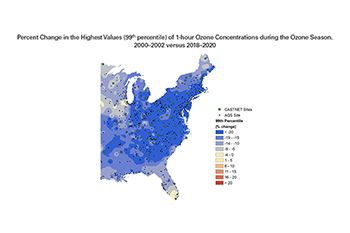
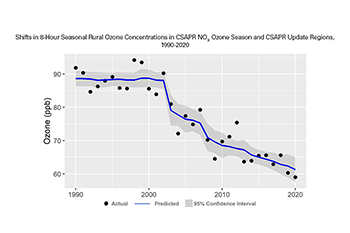
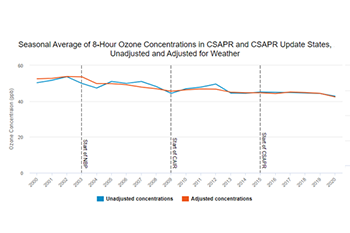
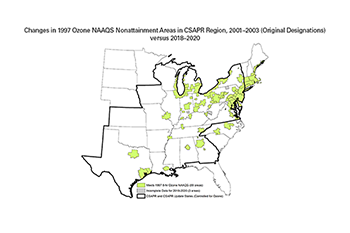
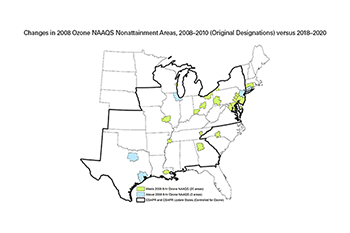
Highlights
Ozone Season Changes in 1-Hour Ozone
- There was an overall regional reduction in ozone levels between 2000–2002 and 2018–2020, with a 23 percent reduction in the highest (99th percentile) ozone concentrations in CSAPR and CSAPR Update states.
- Results demonstrate how NOₓ emission reduction policies have affected 1-hour ozone concentrations in the eastern United States – historically, the region that the ozone policies were designed to target.
Annual Trends in Rural 8-Hour Ozone
- From 2018 to 2020, rural ozone concentrations averaged 63 ppb in CSAPR states, a decrease of 25 ppb (29 percent) from the 1990 to 2002 average period.
- The Autoregressive Integrated Moving Average (ARIMA) model shows how the reductions in rural ozone concentrations correlate with the implementation of the NBP in 2003 (two-year 10 ppb reduction from 2002) and the start of the CAIR NOₓ Ozone Season program in 2009 (two-year 6 ppb reduction from 2007).
- Seven of the eight lowest observed annual ozone concentrations were between 2013 and 2020. Ozone season NOₓ emissions fell steadily under CAIR and continued to drop after implementation of CSAPR in 2015 and CSAPR Update in 2017. In addition, implementation of the mercury and air toxics standards (MATS), which began in 2015, achieves co-benefit reductions of NOₓ emissions.
Ozone Season Changes in 8-Hour Ozone Concentrations
- The average reduction in seasonal mean ozone concentrations (not adjusted for weather) in the CSAPR Update region from 2000–2002 to 2018–2020 was about 9 ppb (18 percent), while the average reduction in the 98th percentile concentrations was about 21 ppb (25 percent) before adjusting for weather-related effects.
- The average reduction in the meteorologically-adjusted seasonal mean ozone concentrations in the CSAPR Update region from 2000–2002 to 2018–2020 was about 10 ppb (20 percent), while the average reduction in the 98th percentile concentrations was about 20 ppb (24 percent) after adjusting for weather-related effects.1.
Changes in Ozone Nonattainment Areas
- Ninety-two of the 113 areas originally designated as nonattainment for the 1997 8-hour ozone National Ambient Air Quality Standard (NAAQS) (0.08 ppm) are in the eastern United States and are home to about 122 million people.2 These nonattainment areas were designated in 2004 using air quality data from 2001 to 2003.3
- Based on data from 2018 to 2020, 90 of the eastern ozone nonattainment areas now show concentrations below the level of the 1997 standard, while the remaining three areas had incomplete data.
- Twenty-two of the 46 areas originally designated as nonattainment for the 2008 8-hour ozone NAAQS (0.075 ppm) are in the eastern United States and are home to about 80 million people.2 These nonattainment areas were designated in 2012 using air quality data from 2008 to 2010 or 2009 to 2011.
- Based on data from 2018–2020, 82 percent (18 areas) of the eastern ozone nonattainment areas now show concentrations below the level of the 2008 standard. While four areas continue to show concentrations above the 2008 standard, three of those areas made progress toward meeting the standard in the 2018–2020 period. It is reasonable to conclude that ozone season NOₓ emission reductions from the NBP, CAIR, CSAPR, and CSAPR Update have significantly contributed to these improvements in ozone air quality.
- Twenty-two of the 52 areas originally designated as nonattainment for the 2015 8-hour ozone NAAQS (0.070 ppm) are in the eastern United States and are home to 76 million people.2 These nonattainment areas were designated in 2018 using air quality data from 2014 to 2016 or 2015 to 2017.3
- Based on data from 2018–2020, three of the 22 eastern ozone nonattainment areas now shows concentrations below the level of the 2015 standard, and an additional 12 areas have made progress toward meeting the standard in the 2018-2020 period.
Background Information
Ozone pollution – also known as smog – forms when NOₓ and volatile organic compounds (VOCs) react in the presence of sunlight. Major anthropogenic sources of NOₓ and VOC emissions include electric power plants, motor vehicles, solvents, and industrial facilities. Meteorology plays a significant role in ozone formation and hot, sunny days are most favorable for ozone production. For ozone, EPA and states typically regulate NOₓ emissions during the summer when sunlight intensity and temperatures are highest.
Ozone Standards
In 1979, EPA established NAAQS for 1-hour ozone at 0.12 parts per million (ppm), or 124 parts per billion (ppb). In 1997, a more stringent 8-hour ozone standard of 0.08 ppm (84 ppb) was finalized, revising the 1979 standard. CSAPR was designed to help downwind states in the eastern United States achieve the 1997 ozone NAAQS. Based on extensive scientific evidence about ozone’s effects on public health and welfare, EPA strengthened the 8-hour ozone standard to 0.075 ppm (75 ppb) in 2008. Finalized in 2016, the CSAPR Update was designed to help downwind states meet and maintain the 2008 ozone NAAQS. EPA further strengthened the 8-hour NAAQS for ground-level ozone to 0.070 ppm (70 ppb) in 2015. EPA revoked the 1-hour ozone standard in 2005 and more recently revoked the 1997 8-hour ozone standard in 2015.
Regional Trends in Ozone
EPA investigated trends in daily maximum 8-hour ozone concentrations measured at rural Clean Air Status and Trends Network (CASTNET) monitoring sites within the states requiring ozone season reductions under CSAPR and CSAPR Update, as well as in adjacent states. Rural ozone measurements are useful in assessing the impacts on air quality resulting from regional NOₓ emission reductions because they are typically less affected by local sources of NOₓ emissions (e.g., industrial and mobile) than urban measurements. Reductions in rural ozone concentrations are largely attributed to reductions in regional NOₓ emissions and transported ozone.
The Autoregressive Integrated Moving Average (ARIMA) model is an advanced statistical analysis tool used to visualize the trend in regional ozone concentrations following implementation of various programs geared toward reducing ozone season NOₓ emissions. To show the shift in the highest daily ozone levels, EPA modeled the average of the 99th percentile of the daily maximum 8-hour ozone concentrations measured at CASTNET sites (as described above).
Meteorologically–Adjusted Daily Maximum 8-Hour Ozone Concentrations
Variations in weather conditions play an important role in determining ozone concentrations. Ozone is more readily formed on warm, sunny days when the air is stagnant. Conversely, ozone production is more limited when it is cloudy, cool, rainy, or windy. EPA uses statistical models to adjust for the variability in seasonal ozone concentrations due to weather to provide a more accurate assessment of the underlying trend in ozone caused by emissions.
Meteorologically–adjusted ozone trends provide additional insight on the influence of CSAPR NOₓ Ozone Season program and CSAPR Update emission reductions on regional air quality. EPA retrieved daily maximum 8-hour ozone concentration data from the Air Quality System (AQS) and daily meteorology data from the National Weather Service for 390 ozone monitoring sites located in the CSAPR Update region. EPA uses these data in statistical models to account for the influence of weather on seasonal average and 98th percentile ozone concentrations at each monitoring site.1
Changes in Ozone Nonattainment Areas
The majority of ozone season NOₓ emission reductions in the power sector after 2003 are attributable to the NBP, CAIR, CSAPR, and CSAPR Update. As power sector emissions are an important component of the NOₓ emission inventory, it is reasonable to conclude that the reduction in ozone season NOₓ emissions from these programs have significantly contributed to improvements in ozone concentrations and attainment of the 1997 ozone health-based air quality standard.
Emission reductions under these power sector programs have helped many areas in the eastern United States reach attainment for the 2008 ozone NAAQS. However, several areas continue to be out of attainment with the 2008 ozone NAAQS, and additional ozone season NOₓ emission reductions are needed to attain that standard as well as the strengthened ozone standard that was finalized in 2015.
In order to help downwind states and communities meet and maintain the 2008 ozone standard, EPA finalized the CSAPR Update in September 2016 to address the transport of ozone pollution that crosses state lines in the eastern United States. Implementation began in May 2017 to further reduce ozone season NOₓ emissions from power plants in 22 states in the eastern US. Starting June 2021, further emission reductions will be required under the Revised CSAPR Update at power plants in 12 of the 21 CSAPR Update states.
More Information
- Clean Air Status and Trends Network (CASTNET)
- Air Quality System (AQS)
- National Ambient Air Quality Standards (NAAQS)
- Ozone Pollution
- Ozone Designations
- Meteorologically Adjusted Ozone Trends
- Nitrogen Oxides (NOₓ) Pollution
- Nonattainment Areas
- EPA’s Clean Air Market Programs
- EPA’s 2020 National Air Quality Trends Report
References
- Wells, B. et al. (2021). Improved Estimation of Trends in U.S. Ozone Concentrations Adjusted for Interannual Variability in Meteorological Conditions. Atmospheric Environment, 248 (2021): 118234.
- U.S. Census. (2010).
- 40 CFR Part 81. Designation of Areas for Air Quality Planning Purposes.